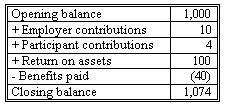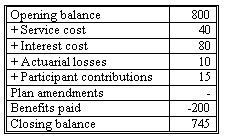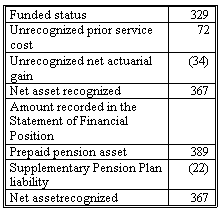- CFA Exams
- 2026 Level II
- Topic 3. Financial Statement Analysis
- Learning Module 11. Employee Compensation: Post-Employment and Share-Based
- Subject 3. Analysis of Pension Plan Disclosures
Why should I choose AnalystNotes?
AnalystNotes specializes in helping candidates pass. Period.
Subject 3. Analysis of Pension Plan Disclosures PDF Download
Pension accounting for defined benefit plans has an "off-balance-sheet" focus, and much of the important information is not disclosed directly on the financial statements. Most of the significant issues can be analyzed based on extensive note disclosure.


Minimum Pension Liability Adjustment 10,000
Additional Pension Liability 60,000
Analysis of reported pension costs and liabilities requires focus on effects of the assumptions used, underlying status of the pension plan, and calculation of non-smoothed pension cost and cash flows of the pension plan.
Understanding the Three Fundamental Features of U.S. Pension Accounting
1. Net pension expense feature.
The recognized consequences of events and transactions affecting a pension plan are reported as a single net amount. A net pension expense (net pension income is possible) includes:
- Expected return on plan assets (income).
- Service costs for benefits earned (additional service provided).
- Interest costs on benefit obligations (passage of time).
- Other "smoothing adjustments".
This amount is reported on the income statement, usually as an "other income or expense." Because of complex smoothing calculations and adjustments these numbers do not record economic reality.
2. Delayed-recognition feature.
Changes in the pension obligation and value of assets are not recognized in their entirely as they occur; instead, they are deferred and amortized over subsequent periods. As a result, accounting measures of periodic pension cost and pension plan status are often not reflective of economic reality. To evaluate the underlying cash flows and consequences of operating events, the analyst must unravel the smoothing and aggregate process.
3. Netting of assets and liabilities.
The value of the plan assets is offset against the actuarially-computed PBO. Assets and obligations are reported net on the balance sheet (usually as part of other assets or liabilities); e.g., a prepaid pension cost (a net assets for over-funded plans) or a prepaid pension obligation (a net liability for an under-funded plan). This affects the company's reported leverage structure, because if the assets were reported on the assets portion of the balance sheet and the plan liabilities were recorded as liabilities, the total assets and liabilities would increase, and this would in turn affect financial ratios. This is permitted for two reasons:
- The company controls the assets in the plan, so it should bear the risks and enjoy the rewards associated with both the assets and liability amounts.
- Use of plan assets is restricted to providing pension benefits, so it is the net funding status of the plan that affects the company's decisions concerning funding and accounting for the plan.
Example
Table 1: Reconciliation of Plan Assets

Table 2: Reconciliation of PBO

Table 3: Plan Status

Importance of Assumptions
The discount rate assumption used to compute the present value has the greatest impact on the reported benefit obligation. A higher (lower) discount rate decreases (increases) the PBO, ABO and VBO.
- The rate has a direct effect on the calculation of service cost as it is used to compute the present value of benefits earned in the current year. A higher (lower) rate reduces (increases) service cost.
- Calculation of the interest component of pension cost (PBO x discount rate) is also affected by the discount rate because both elements of the formula change. Although the effects are opposite, the net result of increasing the discount rate is an increase in the interest cost.
Although the effect on the service cost is offset in part by the interest cost effect, the effect on the service cost is normally much greater. Thus, in most cases, a higher discount rate reduces reported pension cost.
The assumed rate of compensation increase also affects the PBO, but less than the discount rate. A higher (lower) rate increases (decreases) the PBO. The assumed rate is zero for non-pay-related plans. The effect of rate change is easier to predict:
- A higher rate increases both the service cost and interest cost (by increasing the PBO).
- A lower rate decreases all present value calculations and therefore pension cost.
Finally, a higher assumed rate of return on plan assets lowers pension cost, since the expected return on assets is an offset to other components of that cost.
Since only the net pension asset/liability is shown on the balance sheet, the large underlying assets and liabilities can be quite sensitive to assumptions above. A small change in assumptions can cause large changes in pension expense and liability.
Minimum Liability
Minimum liability is recognized when the ABO is greater than the fair value of plan assets. However, no recognition is given in the opposite case. When an accrued pension liability exists, only an additional liability for the difference between the minimum liability and the accrued pension liability can be recorded. When an additional liability is recorded, it is offset by recognizing an intangible asset not exceeding the amount of unamortized prior service cost. If it does exceed that amount, the excess is shown as a reduction of stockholders' equity in an account called net loss not recognized as pension expense.
Assume an accumulated benefit obligation of $500,000, and a fair value of pension plan assets of $400,000, leaving a minimum pension liability of $100,000. If we assume that the accrued pension liability is $40,000, then the additional pension liability is $60,000. The unamortized prior service cost is assumed to be $50,000. The journal entry to record the additional liability is:
Intangible Asset - Pension Plan 50,000
Minimum Pension Liability Adjustment 10,000
Additional Pension Liability 60,000
User Contributed Comments 11
| User | Comment |
|---|---|
| ksamsonov | I will brake my brain with this pension stuff |
| Yurik74 | Mine's already broken. 2 weeks before exam... |
| alai2008 | To ease things. Imagine that you are the person who has the compromise of the pension. All the formulas stuff will go ease if you look at it as the money you owe the money you put in, the return you get ( so you owe less)....etc |
| nofxmeosker | It might go easier - but it doesn't make it any more interesting... if I receive the CFA designation, and end up doing computations on someones pension expense I will blow my brains out. |
| epfrndz | This is actually very useful for asset management and trust banking industries. These types of client accounts start out small but eventually balloon into giant funds. |
| thebkr777 | ^Very true |
| gmsjam | truth is they seem to have reduced some of the tedium with the curriculum on this matter. So count your blessings |
| davidt876 | why aren't the participant contributions or benefits paid the same in tables 1 & 2? |
| blackyosh1 | minimum pension liability = 100,000 or 10,000????? |
| CFAJ | does anybody know where minimum liability is in the book? I cannot find it and this example is very confusing and i don't understand why we are just creating intangible assets out of thin ai |
| jamesleung | increase discount rate should not increase interest cost. because retirement benefit lump sum is discounted to be PBO largely by power of (1+discount rate). Therefore this effect is larger thank d.r itself. |

I was very pleased with your notes and question bank. I especially like the mock exams because it helped to pull everything together.

Martin Rockenfeldt
My Own Flashcard
No flashcard found. Add a private flashcard for the subject.
Add